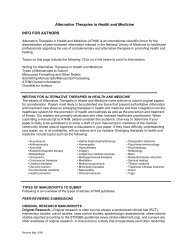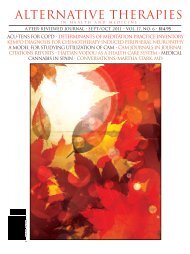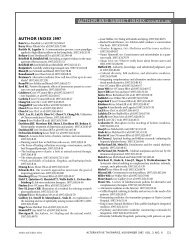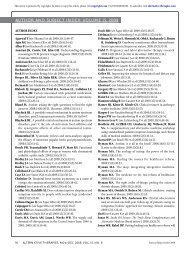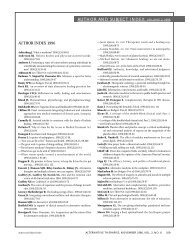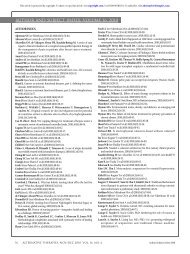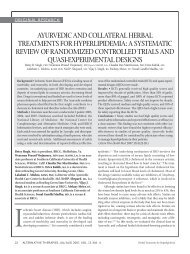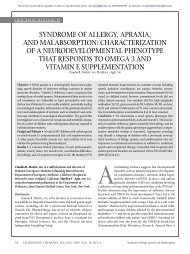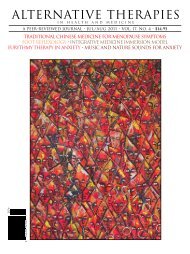Alternative Therapies In Health And Medicine
Alternative Therapies In Health And Medicine
Alternative Therapies In Health And Medicine
Create successful ePaper yourself
Turn your PDF publications into a flip-book with our unique Google optimized e-Paper software.
Table Applied Eurythmy Therapy Exercises (The exercises can be seen on a 20-minute video at http://www.ifaemm.de/F5a_publi.htm.)<br />
Exercise Brief Description of Exercise Therapeutic Goal<br />
<strong>In</strong>troduced in 1st (exploratory) session<br />
Love E<br />
Foot exercise E<br />
IAÅ +<br />
spatial form<br />
B + deep knee<br />
bends<br />
<strong>In</strong>troduced in 2nd session<br />
Walk rhythm<br />
v v - -<br />
Slowly and softly stretch the arms horizontally right and left wide into the periphery,<br />
expressing the feeling of love. Then cross the arms quickly and strongly in front<br />
of the breast. Repeat 10 times<br />
Cross the feet firmly while standing still. Take a step forward and cross again.<br />
Repeat several times going forwards then backwards<br />
I = one arm stretches forward upwards, the other stretches backward downwards<br />
while walking forward; A = the arms stretch upwards in an angle; this gesture is<br />
lowered while walking backwards; Å = the arms form a circle in front while walking<br />
in a circle<br />
An embracing, protective gesture with the arms while slowly sinking with deep<br />
knee bends to the floor<br />
Walk rhythmically: short, short, long, long: ie, two short and two long steps forwards;<br />
repeat backwards<br />
To warm up from the body center towards the<br />
periphery<br />
To release cramp tendency and help “ground”<br />
the patient<br />
To regulate the intensity of the patients focus:<br />
how she does things, how her intention comes<br />
to expression<br />
To loosen tension around the head and ground<br />
the patient<br />
To bring rhythm into the movement<br />
and generally loosen tension<br />
Foot exercise<br />
Yes/No<br />
<strong>In</strong>troduced in 3rd session<br />
Rhythm v v -<br />
yes, v v - no<br />
R<br />
<strong>In</strong>troduced in 4th session<br />
Low pendulum<br />
M<br />
<strong>In</strong>troduced in 5th session<br />
IEE + - v v +<br />
spatial form<br />
<strong>In</strong>troduced in 7th session<br />
Head-shaking<br />
M<br />
Great I<br />
exercise<br />
8th (final) session<br />
Standing with the feet together, swing the left foot in a half-circle forwards and<br />
place it firmly in front = Yes! Repeat 10 times while increasing tempo. Similarly use<br />
the right foot backwards = No! Repeat 10 times while increasing tempo. Finally<br />
“Yes/No” alternating 10 times while increasing tempo<br />
To deepen the breathing<br />
(Discontinued from here onward: Love E and Walk rhythm v v—ie, short, short, long, long)<br />
Beginning with the right foot, walk forwards with rhythm “short, short, long,” then<br />
make a strong yes foot gesture (as in Yes/No) above. Repeat backwards beginning<br />
with left foot + no foot gesture. 10 times<br />
Arms hands and upper body roll a large, vertical wheeling movement forwards<br />
under shoulder height, accompanied by knee bending and stretching<br />
Walk forwards and rock backwards as if against resistance, the arms, legs, and<br />
body meeting this resistance sympathetically<br />
I as above in IAÅ; E = the arms are crossed energetically; the second E gesture is<br />
crossed the other way around—the whole time moving in the room with abrupt<br />
changes in direction—one step for each syllable of a poem in dactyl rhythm, ie, one<br />
long and two short steps; the gestures coordinate exactly with the steps and the<br />
rhythm of the poem<br />
Sitting; shake the head many times sideways while moving alternately the right and<br />
left arm in breast height quietly forwards and backwards as if against resistance<br />
Speak the sound I. The I gesture, as above in IAÅ, is repeated many times raying<br />
out from the center in all directions; similarly the legs and feet are stretched, then<br />
all the arm gestures are repeated: finally “listen” to the body’s reaction<br />
Entire program was overviewed and patient recommended to continue 2 wk more<br />
at home practicing only: Low pendulum M exercise, the Head-shaking M exercise,<br />
and the Great I exercise<br />
To bring rhythm into the movement and<br />
lengthen the breathing out<br />
To relax the breast and back region and so work<br />
through the rhythmical system<br />
To relax muscle tonus and strengthen the<br />
breathing out downward<br />
To strengthen self-confidence by mastering this<br />
inspiring coordination challenge<br />
To relax and quiet the lower body by “sending<br />
the head on holiday”<br />
To encourage self-expression<br />
The patient is Swedish; therefore, the exercises were presented in accordance with Swedish pronunciation. The corresponding English pronunciation is<br />
I = EE (meet), A = AH (father), Å = OH (doe), E = (hay).<br />
Eurythmy Therapy in Anxiety<br />
ALTERNATIVE THERAPIES, jul/aug 2011, VOL. 17, NO. 4 59



